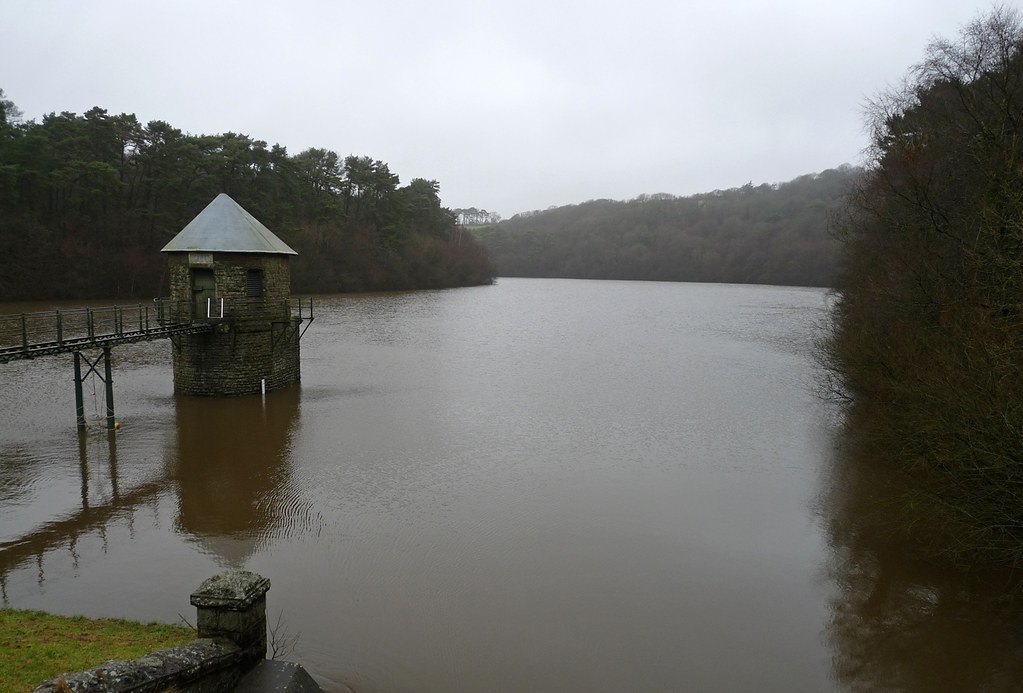I was browsing Google Maps last night looking for promising new locations to explore with the appalling weekend weather forecast in mind. Amazingly I spotted two smallish reservoirs barely ten minutes from home that I didn’t even know were there! They are known as the Lliedi Reservoirs and are in Swiss Valley to the north of Llanelli. After purchasing an OS map of the area en-route (this by the way is a bad thing to do when it’s raining as you end up buying the far more expensive waterproof versions) I soon reached the car park at the top end of Cwm Lliedi. The lower reservoir has been left to develop in as natural a manner as possible meaning the banks are covered in mature mixed woodland and reed beds hug the shallows. After several days of heavy rainfall the river inflow was barely able to pass under the road bridge and at the other end the spillway over the dam was a raging torrent of white water. I briefly considered what it would be like to kayak down it but in reality it would only ever end badly.

I spent a good couple of hours walking the various trails and also headed up onto the cycleway that occupies the trackbed once used by the now defunct Carmarthen railway. It really is a lovely area with very few people around although that may have had something to do with the weather. It shows much promise I think for future visits even though I didn’t see a great deal on this occasion. The highlight was my first couple of Mistle Thrushes of the year as well as a Jay and a large flock of Long Tailed Tit. I think there is a good chance that the rivers in and out of the reservoirs may hold Dipper and Grey Wagtail when not in flood and I can’t rule out a Bittern given the way they have been popping up all over the place recently.
Another new place to which I will have to return is the Mynydd Mawr woodland park near Tumble. Once an old colliery and open cast mining site, the local council has slowly been returning the land back into woodland and meadow to the benefit of the local wildlife. When spring arrives I will definitely be back as it is apparently an important breeding location for Skylark and Marsh Fritillary butterflies are also to be found. I’d love to get photographs of both of those species.
I finished off the day in more familiar territory at Penclawdd to tie in with the outgoing tide and recorded some impressive counts. There were at least three thousand Oystercatcher sitting on the rapidly exposing mud, in which were mixed various Curlew and Redshank. The real treat though was approximately one hundred Pintail, by far the most I have ever seen on Gower. I also counted 140 Shellduck and a somewhat lowly four Wigeon. Five Brent Geese flew downstream from the direction of Loughor which fits in nicely with the movement I saw a few week ago on an incoming tide, during which they were travelling in the opposite direction. I know from past visits to Whitford Point and Salthouse Point that a large number of Brent’s feed there at high tide but there must also be another feeding location further up the estuary. The only problem with confirming that is finding a decent vantage point from which to search when I don’t have access to a large telescope. The Burry Inlet has been known to have up to 1,400 individuals during winter so there should certainly be plenty out there to find.



2 Comments
holdingmoments · January 16, 2011 at 5:57 am
Your newly discovered reservoirs seem to have great potential, once the weather calms down a bit.
Penclawdd sounds an excellent place too. That's a lot of Oystercatchers!
Adam Tilt · January 16, 2011 at 5:00 pm
I certainly hope so. Now where is the sun ….